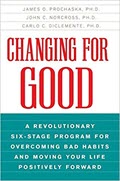Making and Breaking Habits
Bad habits. How do you break them? Good habits. How do you make them?
In the simplest cases, all it takes is a little willpower. For example, if you want to stop uttering filler words like “y’know” and “um,” it’s fairly easy. Be vigilant — notice the impulse to utter that filler — then inhibit it and direct yourself to pause silently instead. With a little practice you can automatize filler-free speech.
Unfortunately, if the change is more significant — if you are trying to stop overeating, or to start exercising, or to stop procrastinating, or to start a new work routine — then it poses multiple difficulties.
For one, it is difficult to make a major change without disrupting one’s way of life. For example, if you start an exercise regimen, you might find you have trouble getting to work on time, or your appetite explodes out of control, or your social life collapses. We all have customary routines. In order to change one aspect of the routine, you need to minimize the disruptive effect on the rest of your life.
Secondly, a problem behavior such as overeating or procrastinating is perpetuated by multiple bad habits that reinforce one another. For example, a procrastinator often gets caught in this vicious cycle: Because he delays starting work, he has to work extremely hard as the deadline approaches. Afterwards, he justifies taking a period of self-indulgent rest to make up for his self-denial during the crunch period. But as he rests, he is in fact delaying the start of work on the next project, and starting the cycle again. To correct the overall problem, you cannot change one isolated habit. You have to dismantle the interconnected system holding the problem in place.
Finally, a significant change usually raises deep emotional issues that need to be addressed. Some bad habits, such as smoking and drinking, temporarily relieve anxiety. Some support rationalizations. A procrastinator might justify poor performance by saying, “This isn’t my best work because I didn’t have enough time.” Some are tools of avoidance. For example, some overeaters use their weight to avoid intimacy. To make a change, you need to confront such emotionally charged issues and rethink them.
In short, a significant change is difficult because one’s customary habits are integrated into a stable, self-reinforcing system that feels emotionally secure. This is why people often need several attempts over a period of years to effect a permanent change.
For those who would like guidance with this complex process, I recommend Changing for Good by James O. Prochaska, John C. Norcross, and Carlo C. DiClemente. [See Note] The authors explain the process of “psychic surgery” that is required to change one’s ingrained habits. Though the book draws its examples from cases of losing weight, stopping smoking, and stopping drinking, the authors properly treat the process as a general one. I had no trouble translating their advice for my own area of interest.
Prochaska and his colleagues’ basic thesis is that habit change has six distinct stages: pre-contemplation, contemplation, preparation, action, maintenance, and termination. They find that different therapeutic methods are needed at each stage. Although they draw techniques from all the main schools of therapy, they derive their theory from the study of real people who have successfully improved their lives. The result is a systematic method, consisting of practical steps to increase one’s desire to change, and to cope with the difficulties along the way.
For example, early on, a person generally has only a vague desire to change. The pros don’t outweigh the cons. The authors show how “consciousness-raising” and “self-re-evaluation” can shift the balance toward change. But they caution the reader that he shouldn’t plunge into action immediately. They have found that premature action usually ends in failure. Further preparation is necessary, to plan how to avoid specific problems and increase immediate benefits. In the book, the authors present an objective test to determine whether or not you are ready to commit to action.
The authors do not believe in condemning oneself to a life of “longing and deprivation.” They seek to help their readers achieve permanent change, by means of creating a new way of life which provides its own rich rewards. When the rewards are rich, the old temptations lose their pull, and there is no conflict. This is what Prochaska and his colleagues seek for their readers.
I find this book inspiring. The steps for change are so clear, so logical, so doable, that I can’t help but be motivated to look at my own habits and ask, “What improvement could I make next?”
Note: I must distance myself from two aspects of the book.
First, it expresses a paternalistic attitude in parts, particularly with respect to smoking. I, a non-smoker, was offended by the attacks on the right to smoke and the smoking industry.
Second, in an appendix the authors grapple with what they see as a contradiction between their advocacy of free will and their role as scientists. I applaud their intention, but I refer readers to Objectivism: The Philosophy of Ayn Rand by Leonard Peikoff for clarification of this issue. There is no contradiction.
Book Information: James Prochaska, John Norcross, & Carlos Diclemente,Changing for Good: A Revolutionary Six-Stage Program for Overcoming Bad Habits and Moving Your Life Positively Forward, Collins Living, 1995.









0 Comments